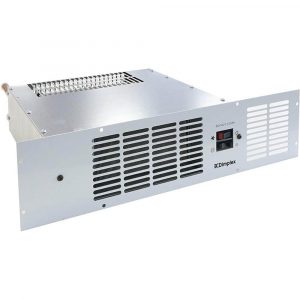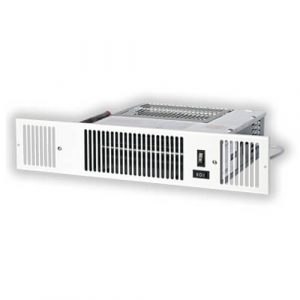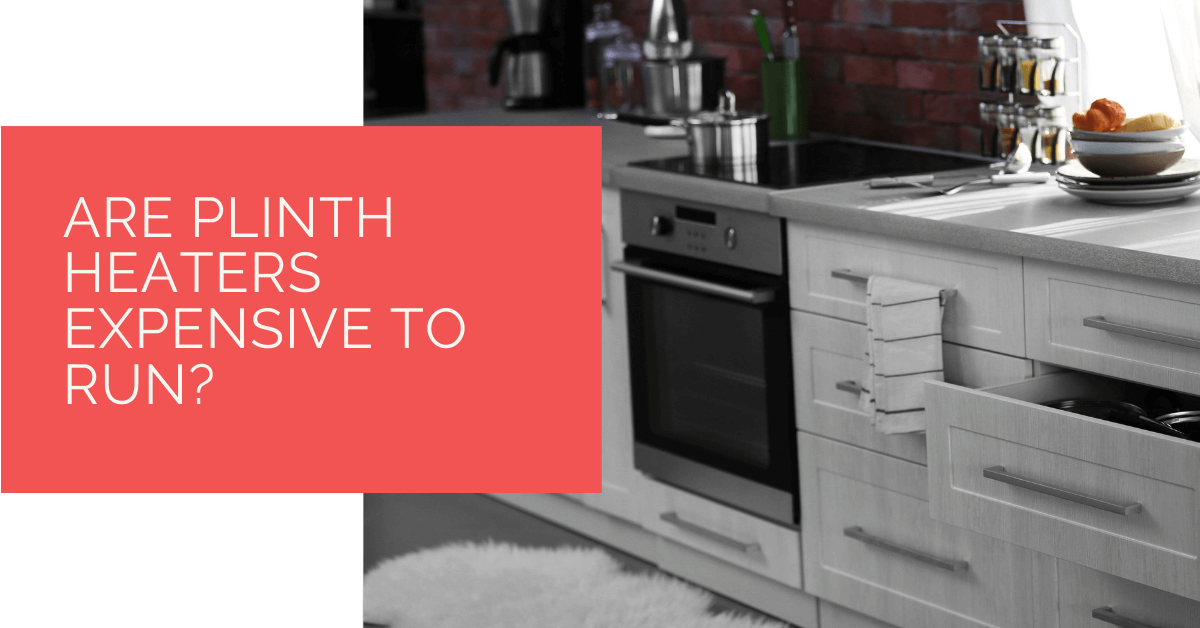Plinth heaters are a smart space-saving choice for heating your kitchen, being both efficient and powerful. They begin to deliver a blast of warm air once turned on at the unit or by remote control, and then spread externally through a grille at your feet.
Are you looking to warm up your cold kitchen but don’t want a higher cost? A plinth heater may be the solution for you if you’re searching for a new option for heating kitchens or wish to make the most of your kitchen area. But is it expensive to run? Read on to know more about plinth heaters.
Contents
Key Takeaways
- Plinth heaters are efficient and space-saving options for heating kitchens, but their running cost depends on your chosen type.
- Electric plinth heaters are relatively more expensive due to their electricity usage, while hydronic plinth heaters, connected to gas boilers, tend to be more cost-effective.
- Plinth heaters are worth considering for their space-saving benefits, energy efficiency, and simplicity of installation.
What Is a Plinth Heater?
A plinth heater is a compact, letterbox-shaped heater that fits perfectly under the kitchen or kitchen cabinets. It is made for those who don’t have enough wall space for a large radiator and want to maximise their kitchen space without compromising heat.
It functions because of its vast surface area, which is in a grill. With the help of an optional fan, it can swiftly and efficiently deliver a large load of heat directly into your room.
Types of Plinth Heaters
There are two different types of plinth heater models.
Electric Plinth Heaters
The name itself should be self-explanatory. Electric plinth heaters are relatively simple to set up since they plug directly into a primary energy source.
Heat is created electrically and circulated throughout the space via a fan. The disadvantage is that they are powered by your electricity supply, making them more expensive to operate.
Hydronic Plinth Heaters
 The second option is a hydronic plinth heater. These are similar to radiators in that they are hooked into your central heating system and receive a supply of hot water that is then disseminated into the room using a fan if needed.
The second option is a hydronic plinth heater. These are similar to radiators in that they are hooked into your central heating system and receive a supply of hot water that is then disseminated into the room using a fan if needed.
While a hydronic plinth heater takes longer to install than an electric counterpart, it is typically less expensive to run if you possess a gas boiler.
How Much Does It Cost to Run a Plinth Heater?
The answer depends on the sort of plinth heater you choose.
Electric Plinth Heater
Electric plinth heaters often have more running costs than hydronic heaters since the former have power supplies. Because electricity has a higher cost per kilowatt than gas, running a heater using electricity is usually more expensive.
Hydronic Plinth Heater
As most homes already have an existing system of gas boilers and radiators, the cost of operating a hydronic plinth heater is minimal. It doesn’t require an electrical connection. However, some versions come with an electric fan to assist in spreading the heat, which adds a modest additional running cost when it’s turned on.
How Does a Plinth Heater Work?
Electric plinth heater
Plinth heaters are powered by a fundamental mechanism that includes an element. The electricity generally powers a conventional electric plinth heater’s heating element and fan. The electricity is utilised to power a fan, drawing air into the heater. The component then heats the air before being circulated by the fan throughout the room.
Hydronic plinth heater
On the other hand, the hydronic models get their heat from the existing central heating system and increase the water temperature. The heat is then transferred to an exchanger subsequently blown over by a fan to generate warm air. Because they don’t contain a heating element, they’re usually less expensive to run.
Are Plinth Heaters Worth It?
There are various reasons why you should consider installing kitchen plinth heaters in your kitchen over conventional radiators.
 The main advantage of a plinth heater is that it saves space compared to a traditional panel radiator. If you don’t have available space in your kitchen, a baseboard heater might be the best option. In addition, compared to retrofitting under floor heating, it might be a cost-effective way to keep the floor warm.
The main advantage of a plinth heater is that it saves space compared to a traditional panel radiator. If you don’t have available space in your kitchen, a baseboard heater might be the best option. In addition, compared to retrofitting under floor heating, it might be a cost-effective way to keep the floor warm.
The kitchen plinth heater is not only a cost-effective way to heat your kitchen, but also efficient in terms of both power consumption and heat production. It is inexpensive to operate and maintain, not to mention quite simple to set up.
Plinth Heater FAQs
Are Plinth Heaters Energy Efficient?
Did you know that a wet plinth heater is powered by your central heating system and uses very little energy to heat? It consumes around 25% less energy than traditional radiators and thus heats a space in less than half the time!
Are Plinth Heaters Safe?
Only a few electric plinth warmers offer the necessary safety features. However, a plinth heater is generally highly safe, as it is equipped with an overheat protection switch that shuts off the power when it senses potentially harmful overheating.
Are Hydronic Plinth Heaters Noisy?
Plinth heaters are loud, but they’re fantastic on a cold morning when you get a hot room. That indeed compensates for the noise.
Can You Put a Freezer Next to A Plinth Heater?
Avoid putting a fridge freezer near the plinth heater since it will have to work more to maintain the appropriate interior temperature.
Heat Pump Source: Reliable Heating and Cooling Solutions
At Heat Pump Source, we take pride in our unwavering commitment to serving the UK with top-tier HVAC solutions. From the efficiency of heat pumps and the cool relief of air conditioning to the warmth of boilers, radiators, and underfloor heating, our dedicated team is always at the forefront of innovation. We understand the unique needs of every household and business, and we strive to provide dependable health and cooling products and services that are tailored just for you. Ensuring your comfort and satisfaction is our utmost priority. Whether you have questions, need guidance, or require support, we’re always here to assist. Please don’t hesitate to contact us; we’re eager to be of service.
Conclusion
Plinth heaters offer an efficient and space-saving solution for heating your kitchen. The choice between electric and hydronic models will impact your running costs, with electric heaters typically being more expensive to operate due to their electricity consumption. However, the benefits of space-saving design, energy efficiency, and ease of installation make plinth heaters valuable to your kitchen. Ultimately, the decision to invest in a plinth heater should be based on your specific needs and budget, but they can certainly provide a cost-effective way to keep your kitchen warm and cosy.
About the Author
At Heat Pump Source, our articles are the product of a collaborative effort among a team of highly skilled HVAC experts. Our dedicated professionals, hailing from diverse backgrounds in heating, ventilation, air conditioning, and refrigeration, contribute their extensive knowledge and experience to every piece of content. This multidisciplinary approach ensures comprehensive coverage. Our commitment is to deliver authoritative, reliable, and tailored advice to meet the unique needs of every household and business across the UK.

